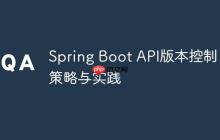-

- Spring Boot API版本控制:策略与实践
- API版本控制是现代服务开发中的关键实践,旨在确保在API演进过程中保持向后兼容性,并有效管理客户端的升级过渡。本文将深入探讨API版本控制的必要性,并详细介绍在SpringBoot应用中实现基于URL路径的版本控制策略,包括在单个控制器内处理多版本以及更推荐的多控制器分离方案,并提供相应的代码示例和最佳实践建议。
- 后端开发 . spring-boot 535 2025-08-28 20:07:01
-

- PostgreSQL存储过程到Spring Boot原生SQL查询的迁移指南
- 本文详细介绍了如何将PostgreSQL数据库中的存储过程(SP)逻辑转换为SpringBoot应用中可直接使用的原生SQL查询。通过分析原始SP的结构和功能,文章提供了两种在SpringDataJPA的@Query注解中集成SQL查询的方法:使用命名参数和使用序号参数,并附带示例代码,旨在帮助开发者实现数据库逻辑的解耦和Java应用的简化。
- 后端开发 . spring-boot 681 2025-08-28 19:24:01
-

- 将PostgreSQL存储过程转换为Spring Boot原生查询的实践指南
- 本文旨在指导开发者如何将PostgreSQL存储过程转换为SpringBoot应用中的原生SQL查询。通过分析一个具体的存储过程,我们将详细演示如何构建等效的SQL查询,并介绍SpringDataJPA@Query注解中两种主要的参数映射方式:命名参数和位置参数,以实现存储过程的替代。
- 后端开发 . spring-boot 493 2025-08-28 18:42:01
-

- 从 Thymeleaf 向 Controller 传递不在视图中使用的值
- 本文介绍了如何在SpringBoot项目中,使用Thymeleaf模板引擎向Controller传递用户身份信息,而无需在视图层显式展示或让用户输入。通过@AuthenticationPrincipal注解,可以直接在Controller中获取当前认证用户的身份信息,从而避免在视图中传递敏感信息,并简化代码逻辑。
- 后端开发 . spring-boot 185 2025-08-28 16:28:36
-

- WebLogic部署Spring Boot SAML应用时的类加载冲突解决方案
- 本文旨在解决SpringBoot1.5SAML应用在WebLogic12C上部署时遇到的IncompatibleClassChangeError。通过深入分析WebLogic类加载机制与第三方库冲突,提供了一种基于weblogic.xml中prefer-application-packages配置的有效解决方案,确保应用能够正确加载其依赖库,避免与容器内置库的版本冲突,从而成功部署。
- 后端开发 . spring-boot 164 2025-08-28 16:27:01
-

- WebLogic部署Spring Boot SAML应用中的类加载冲突解决策略
- 本文旨在解决SpringBoot1.5应用在集成SAML2后部署至WebLogic12C时遇到的IncompatibleClassChangeError。通过分析WebLogic的类加载机制与应用程序依赖的冲突,提出并详细阐述了在weblogic.xml中配置prefer-application-packages来优先加载应用程序特定库的解决方案,确保SAML相关XML解析器与WebLogic内置库的兼容性,从而成功部署应用。
- 后端开发 . spring-boot 938 2025-08-28 16:12:25
-

- VSCode怎么用Java语言_VSCode配置Java开发环境与项目创建教程
- 答案:VSCode通过安装JDK和Java扩展包可高效开发Java,支持运行调试,配置多模块项目及远程调试,适合轻量与多语言场景,但复杂项目和企业框架支持上弱于IntelliJIDEA。
- 后端开发 . spring-boot 1024 2025-08-28 15:39:01
-

- 怎么给VSCode配置Java_VSCode搭建Java开发环境与项目设置教程
- 答案:配置VSCode写Java需安装JDK和Java扩展包,设置环境变量与运行时路径,可高效开发并管理多项目。
- 后端开发 . spring-boot 691 2025-08-28 15:03:11
-

- 用VSCode怎么写Java_VSCodeJava开发环境搭建与代码编写教程
- 答案:使用VSCode进行Java开发需配置JDK、安装VSCode及Java扩展包,创建项目后可编写、运行和调试代码。其优势在于轻量、多语言支持和高可定制性,适合中小型项目与多语言开发者,但复杂企业级项目支持较弱。常见问题可通过检查JDK路径、重启语言服务、查看输出日志等方式排查。调试时可利用断点、条件断点、日志断点及调试控制台高效定位问题。Maven/Gradle项目能被自动识别并集成,支持依赖管理和构建任务执行,单元测试也可在VSCode中便捷运行。
- 后端开发 . spring-boot 960 2025-08-28 14:15:01
-

- VSCode怎么写JAVA项目_VSCode创建与开发Java项目完整教程
- 答案是:配置VSCode写Java需三步——装JDK、配环境变量、装Java扩展包;创建项目用命令面板选Maven/Gradle;通过设置JDK路径、代码格式化、调内存提升效率;常见问题如语言服务器失败可清缓存或重启解决;依赖管理靠pom.xml或build.gradle,VSCode侧边栏提供Maven/Gradle任务快捷运行,结合命令行更灵活。
- 后端开发 . spring-boot 949 2025-08-28 13:56:01
-

- IDEA 2021.3 正式发布:支持远程开发、故障排查、Java和Spring等多项优化改进
- 在这个版本中,远程开发功能仍处于BETA阶段,但它已经能够让我们体验到IDEA“远程开发”带来的全新体验。借助这个功能,我们能够从世界任何角落轻松连接到运行IntelliJIDEA后端的远程计算机。所有处理任务都将在这台高性能的远程计算机上执行,您将能够像在本地计算机上一样流畅地处理项目。要使用该功能,只需在IntelliJIDEA的欢迎屏幕或通过ToolboxApp中新增加的JetBrainsGateway应用程序启动即可。此远程开发功能不仅能满足日常编码需求,还能与JetBrainsSpac
- 后端开发 . spring-boot 146 2025-08-28 10:48:21
-

- Spring工具套件使用指南
- 今天给大家带来SpringToolSuite的使用教程,内容清晰明了,希望能为正在学习的你提供一些帮助。1、首先,下载并安装SpringToolSuite开发环境。2、根据自己的系统选择合适的版本进行下载,解压后直接运行STS.exe即可启动工具。3、创建新的SpringBoot项目:点击菜单栏的“文件”,选择“新建”,然后点击“SpringStarterProject”开始项目创建流程。4、填写项目相关信息后,点击“下一步”继续操作。5、按照实际开发需求勾选所需依赖组件,确认无误
- 后端开发 . spring-boot 805 2025-08-28 08:35:21
-

- Spring Data Elasticsearch:自动化生成并应用索引映射
- 本文介绍了如何利用SpringDataElasticsearch自动生成并应用索引映射。通过简单的代码示例,展示了如何在应用启动时检查索引是否存在,并根据实体类的@Document和@Field注解自动创建索引和映射,从而简化Elasticsearch索引管理的流程。
- 后端开发 . spring-boot 592 2025-08-27 17:45:01
-

- Spring Data Elasticsearch:自动生成实体映射的实践指南
- 本文详细介绍了如何在SpringDataElasticsearch应用中,利用IndexOperations的createWithMapping()方法,根据实体类(如@Document和@Field注解定义的Person类)自动生成并应用Elasticsearch索引映射。通过检查索引是否存在,此方法能确保在应用启动时高效、准确地创建索引及其完整的字段映射,从而简化开发流程并减少手动配置错误。
- 后端开发 . spring-boot 510 2025-08-27 17:13:01
-

- 如何开发C2C分销移动App应用?
- C2C(消费者对消费者)模式借助移动App应用彻底重塑了人们的交易行为。一个高效的C2C分销平台能够直接打通个体买家与卖家之间的连接,激发巨大的市场潜力。如果您正考虑切入这一赛道,本文将为您全面拆解开发C2C分销移动App的核心流程与关键要素。第一步:深入市场调研与精准定位在编写任何代码前,扎实的市场调研是项目成功的前提。目标用户分析:明确您的平台服务对象——是主打二手物品流转,还是聚焦于原创手工艺品交易?清晰描绘用户画像,包括年龄、消费习惯、使用场景等。竞品研究:深入分析主流平台(如闲鱼、转转
- 后端开发 . spring-boot 502 2025-08-27 13:22:01

PHP讨论组
组员:3305人话题:1500
PHP一种被广泛应用的开放源代码的多用途脚本语言,和其他技术相比,php本身开源免费; 可以将程序嵌入于HTML中去执行, 执行效率比完全生成htmL标记的CGI要高许多,它运行在服务器端,消耗的系统资源相当少,具有跨平台强、效率高的特性,而且php支持几乎所有流行的数据库以及操作系统,最重要的是





























